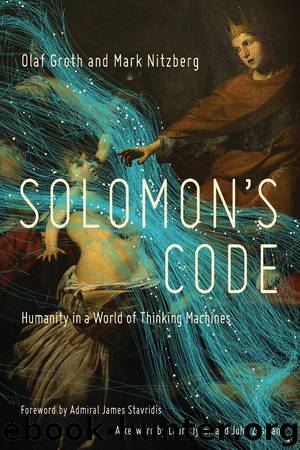Solomon's Code by Olaf Groth

Author:Olaf Groth
Language: eng
Format: epub
Publisher: Pegasus Books
Published: 2018-10-11T16:00:00+00:00
ASTRO BOY
Astro Boy made his manga debut back in 1952, but he lived in a future, science-fiction world where humans and robots coexisted in harmony. An android with human emotions, Astro was created by the head of the Ministry of Science to replace his lost son, who died in a self-driving car accident. The protagonist, known as “Mighty Atom” to the many Japanese who followed the series over the next sixteen years in Weekly Shōnen Magazine, would soon disappoint the inimitable Dr. Umataro Tenma, who realized the android could not replace the void of his lost boy. Astro would be sold to a robot circus, saved by a magnanimous professor, become part of a robotic family, and set off on various adventures.
The 112 chapters of the series, along with the subsequent remakes and spin-offs it inspired, now rank among the most influential forces in the history of Japanese manga and anime. But Astro Boy also provides one of the earliest pop-culture references for the more-symbiotic mindset that Japanese citizens hold for human-robot interaction. The greater affinity for androids and robots has tangible roots in demographics and economics—primarily as a replacement for a shrinking labor pool—but it also grows out of a philosophical tradition that doesn’t consider humans exceptional in the ways that Western traditions do. It’s no surprise, then, that the leading edge of Japanese AI tends to revolve around humanoid and other robotics, with development of both leading toward what some Japanese experts call “Society 5.0.”
The urgency today stems primarily from the demographic cliff the country faces. Low rates of procreation, and an aversion to immigration, have flipped Japan’s age pyramid onto its point, leaving companies in a scramble to replace retiring workers. “Labor saving technology of any kind is critical,” says Kenji Kushida, a Japan Program Research Scholar at Stanford University’s Walter H. Shorenstein Asia-Pacific Research Center. “That’s where AI and robotics really come in.” However, the latest generation of robots was born into a limbo, caught between two popular conceptions. While robots do far more in 2018 than the traditional factory machines programmed to do one task repeatedly, they remain a far cry from the sci-fi humanoids of Hollywood and Japanese anime.
Still, in this middle ground, developers have made significant gains on the twin tasks of robot perception and grasping, thanks largely to new applications of machine learning. These advances have pushed robotics near a breakthrough in the grasping of arbitrarily shaped objects, such as pine cones, pencils, or wine glasses. “I’ve been working on the grasping problem for 35 years, and now, with cloud robotics collectively learning from millions of examples, I feel we are getting close to solving it,” says Ken Goldberg, head of UC-Berkeley’s Center for People and Robots.
Solving the grasping problem would move us one step closer to creating a humanoid robot, but neither grasping nor perception help much in everyday situations if the robot doesn’t also possess some basic temporal and causal sense about the environment in which it operates. That sort
Download
This site does not store any files on its server. We only index and link to content provided by other sites. Please contact the content providers to delete copyright contents if any and email us, we'll remove relevant links or contents immediately.
Learning SQL by Alan Beaulieu(6237)
Weapons of Math Destruction by Cathy O'Neil(6214)
Digital Minimalism by Cal Newport;(5704)
iGen by Jean M. Twenge(5384)
Sapiens by Yuval Noah Harari(5322)
The Age of Surveillance Capitalism by Shoshana Zuboff(4243)
Elon Musk by Ashlee Vance(4084)
Thing Explainer by Randall Munroe(3909)
Apollo 8 by Jeffrey Kluger(3667)
Future Crimes by Marc Goodman(3562)
The Science Book (Big Ideas Simply Explained) by DK(3252)
Who Can You Trust? by Rachel Botsman(3110)
The Innovators: How a Group of Hackers, Geniuses, and Geeks Created the Digital Revolution by Walter Isaacson(2991)
I Live in the Future & Here's How It Works by Nick Bilton(2959)
Infinite Energy Technologies by Finley Eversole(2952)
Steve Jobs by Walter Isaacson(2857)
Dawn of the New Everything by Jaron Lanier(2751)
Chernobyl by Serhii Plokhy(2514)
Ben Franklin's Almanac by Candace Fleming(2492)
